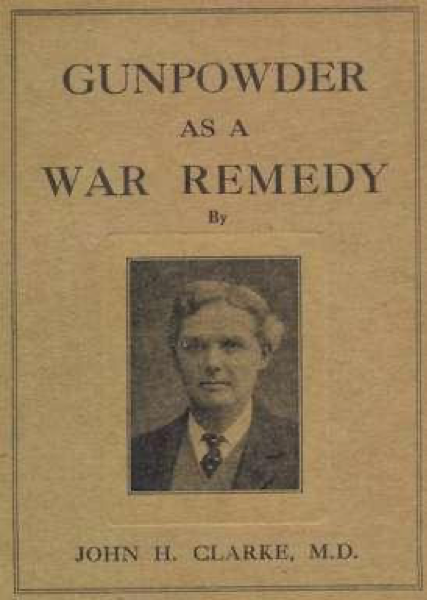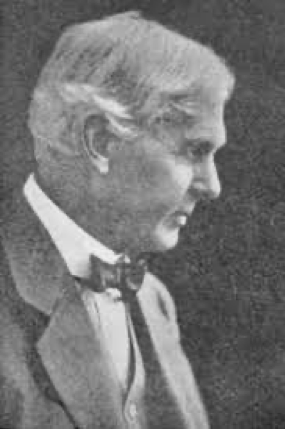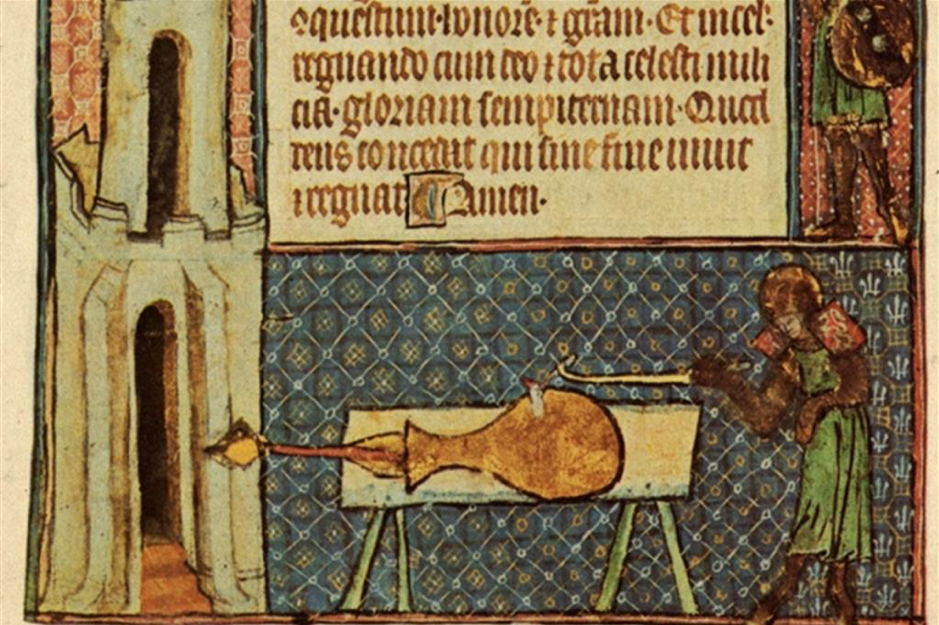
Gunpowder: rimedio della guerra (1915)
Traduzione e redazione a cura di Anna Fontebuoni
Biologa
anna.fontebuoni@gmail.com
In piena Prima guerra mondiale l’omeopata inglese Clarke scoprì l’azione incredibile di Gunpowder sulle piaghe infette, setticemie, pustole e qualsiasi processo suppurativo. Le riviste non scientifiche dell’epoca si impadronirono delle informazioni e il rimedio diventò di dominio pubblico. Lo usarono persino i vigili del fuoco e gli agenti di polizia.
Clarke ci teneva a sottolineare l’importanza della dinamizzazione ottimale: 3dh, da assumere sotto forma di granuli o, meglio, in triturazione ogni due ore in caso di piaghe infette e febbre, altrimenti ogni tre. Una sola dose era sufficiente come preventivo, anche per la meningite cerebrospinale. Altre indicazioni erano: ascessi, foruncoli, antrace, eczema, punture di insetti, infette o no, e ferite chirurgiche, da trattare con una dose ogni ora secondo l’urgenza.
Gunpowder non è altro che la comune polvere da sparo, composta di soda caustica, carbone, zolfo e salnitro, cioè Sulphur + Calcarea carbonica + Kalium nitricum.
Era tradizionalmente usata a questo scopo in dosi ponderali da militari indiani per ferite da arma da fuoco, dai Nativi americani e canadesi per trattare morsi di serpenti e dai pastori dell’Anglia orientale per prevenire ferite infette delle pecore. Il proving fu eseguito da Clarke stesso: la 2dh gli provocò un herpes facialis molto grave, dal sopracciglio al lato destro del naso, lasciandogli cicatrici permanenti. La 3dh produsse i disturbi citati prima. La keynote era l’infezione, in tutte le sue forme.
Dr. Robert Séror
Capitolo III: esempi dell’azione curativa di Gunpowder
H.J.S., sottufficiale di artiglieria di un reggimento indiano, nato in India da genitori inglesi e sempre vissuto là, venne in visita da me il 9 aprile 1913, in condizioni pressoché disperate.
Era un uomo dal fisico robusto, ma con pelle cadente e coperto di ulcere cutanee dalla testa ai piedi, alcune con essudato, alcune con croste grandi quanto una moneta e macchie color rame sulle zone in cui si erano formate le ulcere o le pustole.
Mi disse che due anni prima aveva avuto un attacco di “foruncoli”, che si era ripetuto sei mesi prima. Gli episodi si erano susseguiti a intervalli di quattro-cinque mesi, fino a quello attuale. Tutti i tentativi di cura erano falliti e gli era stato consigliato di tornare in Inghilterra e cambiare aria. H.J.S. era molto stimato dai suoi superiori. Era istruttore di atletica, completamente astemio ed esperto in armi da fuoco. Per non fargli perdere lo stipendio durante l’assenza, gli ufficiali gli offrirono un corso di istruzione a Woolwich. Quando lo conobbi era in Inghilterra da sei settimane. Invece di migliorare, le sue condizioni si erano costantemente aggravate e durante il viaggio aveva sofferto di diarrea. Digeriva male e il sonno era interrotto dai dolori. Aveva perso 12 kg nelle ultime 4 settimane, e in totale 30 kg. Collo, tronco ed arti erano tutti coperti di piaghe. Le ghiandole inguinali erano molto gonfie e dolenti.
Cercando di risalire all’origine del problema, riscontrai che in precedenza aveva sempre goduto di ottima salute. Nel 1894, però, era stato morso a un dito da uno scoiattolo e il dito si era infettato, dimostrando un certo grado di sensibilità alla setticemia.
Aveva avuto episodi febbrili, quasi sempre in associazione con la comparsa delle pustole. Il primo attacco era avvenuto a fine novembre del 1911. A fine ottobre dell’anno precedente era stato vaccinato per la seconda volta in vita sua e l’aveva ”presa bene”. Ma era chiaro! Per me era evidente il rapporto fra la malattia e la vaccinazione, tanto più che un suo collega militare, vaccinato nello stesso periodo, si era ammalato anche lui con sintomi simili. Quest’uomo però aveva cattive abitudini e si era dato all’alcol, su consiglio degli ufficiali medici. Il mio paziente, essendo astemio, non aveva seguito la loro prescrizione. L’unica altra ipotesi era la sifilide, probabilità che aveva sempre negato e che era stata confermata da più Wassermann ripetute, tutte negative.
Senza esitazioni diagnosticai una vaccinosi, secondaria o terziaria. Le pustole erano effettivamente più grosse e perduravano più a lungo sul braccio destro, nel punto d’inoculo del vaccino. Il fatto che il braccio destro fosse più colpito era stato spiegato dai medici con l’eccessiva attività fisica dell’uomo. che praticava cricket, bowling ecc.!
Gli prescrissi Gunpowder 3dh, 8 granuli 3 volte al giorno e Thuja 200ch tre dosi in una settimana. Alla fine della settimana era un uomo nuovo.
L’appetito era talmente migliorato che aveva avuto problemi digestivi e diarrea per aver mangiato troppo. In generale la pelle aveva un aspetto migliore.
Il 24 aprile pesava 68 kg. Era molto ingrassato, anche se non sapevo esattamente quanto pesasse quando si era presentato da me la prima volta. Il 5 giugno pesava 75 kg e il 18 settembre 79 kg. Il miglioramento era costante.
Ogni tanto comparivano nuovi gonfiori e pustole e alcune ulcere con croste sulle mani, appena sotto il polso, specialmente a destra, lato sempre più colpito.
Interruppi Gunpowder e gli diedi Silicea 3 dh, sempre a dosi di 8 granuli, e Thuja tre volte a settimana. A questo punto avvenne un rapido cambiamento. Ricomparvero le pustole, la diarrea, sapore amaro in bocca e lingua patinosa e un po’ di febbre.
La diarrea peggiorava dopo aver bevuto latte. Il peso scese a 73 kg, ma sulle mani erano scomparse le pustole. Trombidium 200ch guarì immediatamente la diarrea, poi gli prescrissi ancora Gunpowder 3dh 8 granuli ogni 4 ore e non più Thuja.
Il 16 ottobre stava di nuovo molto meglio in generale e il peso era salito a 77 kg.
Poco tempo dopo, dovendo rientrare dalla licenza, tornò in India, in ottima salute, dopo aver concluso con successo il corso di istruzione.
Gli fornii una buona scorta di Gunpowder da portare con sé e gli dissi di scrivermi se avesse avuto ricadute. Da allora non ho più saputo niente, e ho dedotto che abbia ripreso le armi e sia in guerra da qualche parte.
Ecco alcuni altri casi che mi sono capitati:
Morso avvelenato
Una donna, con pelle molto sensibile, fu punta su un piede da un moscerino. Il piede si gonfiò, infiammò e andò in suppurazione. Intorno al morso c’era un alone circolare di infiammazione, che continuava ad allargarsi e a staccare l’epidermide man mano che si diffondeva. Dopo aver provato inutilmente vari rimedi, Gunpowder 3dh 8 granuli tre volte al dì la guarì completamente.
Taglio avvelenato
Un uomo si era tagliato malamente con un coltello l’indice della mano sinistra. La ferita rifiutava di cicatrizzare. Dall’epidermide si staccava un anello di infiammazione che si diffondeva sempre più. Lachesis e altri rimedi non avevano dato risultati. Gunpowder 3dh lo guarì rapidamente.
Intossicazione da gas di depurazione
Una donna rimase gravemente intossicata da gas di depurazione. Il braccio destro e le ghiandole ascellari erano molto gonfi. Tre mesi dopo l’incidente venne da me: l’articolazione del gomito del braccio destro era praticamente bloccata dal gonfiore e minacciava di infettarsi sopra e sotto. Le ghiandole ascellari erano grosse come un uovo di gallina. Gunpowder 3dh risolse il problema gradualmente e nonostante la cura dovesse essere interrotta da un attacco di morbillo, la donna recuperò pienamente la mobilità dell’arto.
Nel caso seguente si dimostra l’utilità di Gunpowder anche nei terremoti, calamità con effetti molto simili alla guerra.
Intossicazione da polvere di terremoto
Nel 1912 ebbi come paziente una signora che era rimasta coinvolta nel forte terremoto che anni prima aveva devastato gran parte della Giamaica. Mi chiese cosa potevo fare per la sua nipotina di 4 anni, che viveva in Giamaica e soffriva di un disturbo della pelle. La piccola era nata subito dopo il terremoto, era molto minuta, sempre nervosa e soffriva, come molti altri bambini della stessa età della colonia, di eruzioni cutanee. Era come se il l’evento disastroso avesse fatto risalire dalle profondità della Terra un nuovo tipo di polvere irritante e intossicante.
I primi sintomi erano “calore pungente” con molto prurito. Poi erano comparse pustole con vesciche da cui era fuoriuscito un liquido. Le parti colpite erano soprattutto le caviglie e il busto. Ogni puntura di zanzara provocava una ferita infetta. La piccola paziente era apatica, nervosa di notte e aveva il sonno agitato. Questo mi aveva riferito la zia. Pensai subito che il suo rimedio potesse essere Gunpowder e il 4 gennaio 1912 le inviai una scorta di polvere alla 5dh.
A tempo debito ricevetti un resoconto: nel giro di una settimana le sue condizioni erano molto migliorate. Dormiva meglio, andava regolarmente di corpo e aveva appetito, e mentre prima doveva essere convinta a mangiare qualsiasi cosa, ora il cibo non le bastava mai. Allo stesso tempo anche la pelle era migliorata. Il 30 aprile le inviai un’altra scorta di polvere, perché aveva avuto una ricaduta dell’eruzione con febbre. Da allora migliorò costantemente e rimase in buona salute.
Allego questa nota editoriale pubblicata su Homoeopathic World del 1° giugno con le osservazioni di un altro omeopata.
Infiammazione settica del pollice
“Mi stanno continuando ad arrivare casi di Gunpowder. L’ultimo è un’infiammazione settica del pollice di un’infermiera di 19 anni. La ragazza è stata trattata chirurgicamente e ripulito il pus, ma l’infiammazione è progredita e si prospettava la perdita di un’articolazione. Un breve trattamento con Gunpowder 3dh è riuscito a guarire e cicatrizzare la parte.”
Chapter III: Examples Of The Curative Action Of Gunpowder.
In addition to the cases related by Mr. Upcher it may be of interest to record a few of my own. First, I will give that of the gunner, whose case I related in the article already referred to. It will be noticed that in this case I gave other remedies besides Gunpowder, but the progress of the case showed that the Gunpowder was the chief agent in the curative work.
- J. S., 30 a non-commissioned artillery officer in an Indian regiment, who had been born in India of English parents, and had never before left it, presented himself to me on April 9th, 1913, in a fairly desperate condition. He was a man of very powerful physique, but his flesh was hanging about him, and he was covered from head to foot with sores, some discharging, some having rupia-like crusts, coppercoloured stains marking the areas where sores or ” boils ” had previously been. His story was as follows. About two years before he had had an outbreak of ” boils,” and six months later another attack. At intervals of four or five months he had other attacks, ending up with the present one. All attempts to cure him having failed, he was advised that the only thing for him was a voyage to England and a change of air. H. J. S. was greatly valued by his superiors. He was an instructor in athletics, a total abstainer, and an expert gunner. In order that he might not lose his pay whilst absent from India, his officers had very kindly arranged for him a course of instruction at Woolwich. He had been six weeks in England when he came to me. So far from the change benefiting him, he had become steadily worse. He had had diarrhoea during the voyage home. His digestion was bad and his sleep broken by the pains of his sores. He had lost two stones in weight in four weeks; altogether he had lost five stones. The neck, trunk, extremities were all affected. The inguinal glands were much swollen and painful. On trying to get at the origin of the trouble, I ascertained that his previous health had been excellent. But in 1894 he had been bitten in the finger by a squirrel and his finger had been bad for a long time afterwards. This showed a degree of susceptibility to blood-poisoning. He had had attacks of fever, but almost always in association with the attacks of ” boils.” The first attack occurred the end of November, 1911. At the end of the previous October he had been vaccinated, for the second time in his life, and it “took well.”It did, indeed ! To me, the connection was obvious between the present state and the vaccination. At the same time as my patient, a fellow soldier was also vaccinated, and he also soon afterwards became ill, in a somewhat similar way. But this man was not temperate in his habits, and his illness was put down to alcohol by his medical officers. This would not do for my patient, who was a life abstainer. The only other hypothesis was syphilis. The possibility of this he steadily denied, and his word was borne out by the Wassermann tests, which consistently gave negative results, though tried again and again. My diagnosis was unhesitatingly – VACCINOSIS, secondary or tertiary. This was confirmed by the fact that the sores were thickest and lasted longest on his right arm on the site of the vaccination scars. The fact that his right arm was worse, was explained by his doctors as being due to over-exertion at cricket, bowling, etc .! I ordered him Gunpowder 3x eight grains three times a day ; and Thuja 200 three doses in the week. At the end of the week he was a changed man. He had still plenty of sores, but they were healing, and the whole aspect of the man was different. His appetite had improved to such an extent that some indigestion and diarrhoea had resulted from overindulgence. His skin had improved altogether in appearance.
On April 24th his weight was 10 st 11 lbs. He had then gained much, but I have no record of his weight when he first came to me.
On June 5th he was 11 st. 11 1/2 lbs. and on September 18th, 12 st. 6 1/2 lbs. He had steadily improved all this time. New swellings or ” boils ” occasionally appeared, and some sores with thickening on the hands, just below the wrists, especially the right, had proved particularly obstinate. I now omitted Gunpowder and gave instead Silica 3x in eight-grain doses in the same way; Thuja 200, thrice a week, being continued as before.
A rapid change took place. A new outbreak of boils occurred, diarrhoea set in, with bitter taste and coated tongue and some fever. The diarrhoea was worse after drinking milk. The weight had gone down to 11 st 8 lbs., but the hands were much better. Trombid. 200 soon cured the diarrhoea, and then I gave Gunpowder 3x eight grains every four hours alone; leaving off the Thuja. On October 16th he was very much better again in every way, his weight having gone up to 12 St. 2 1/2 lbs. Soon after this, his time being expired, he left for India after successfully completing his course of instruction, in very good condition. I gave him a good supply of Gunpowder to take home with him, and told him to let me know if he had any relapse. As I have heard nothing since, I conclude he is now busy with his guns somewhere in the widespread area of the war.
Here are a few other cases of mine:
Poisoned Bite.
A lady, who had a very sensitive skin, was bitten by a gnat on the foot, resulting in swelling, inflammation and suppuration. There was a ring of inflammation round the bite, constantly spreading and detaching the epidermis as it spread. After the failure of several remedies, Gunpowder 3x eight grains three times a day rapidly cured.
Poisoned Cut.
A gentleman had a bad cut with a knife on the left index finger. The wound refused to heal. An inflammatory ring stripped off the epidermis and spread more and more. Lachesis and other remedies failed to make any impression. Gunpowder 3 X rapidly cured.
Sewer-Gas Poisoning.
A lady was very severely poisoned by sewergas. There followed swelling of the right arm and axillary glands of the right side. When she consulted me, three months after the accident, the right arm was almost fixed at the elbow-joint with swelling. It threatened suppuration above and below. The axillary glands were as large as a hen’s egg. Gunpowder 3x gradually resolved the trouble, and though the cure was interrupted by an attack of measles, the mobility of the arm was fully restored.
The following case shows that as earthquakes and war are placed in the same category of calamities, Gunpowder may prove of service in some of the ills caused by the one as well as the other.
Blood-Poisoning From Earthquake Dust.
In 1912 I had under my care a lady who had been in the great earthquake which wrought so much havoc in Jamaica some years before. She asked me if I thought I could do anything for her little niece, aged 4, who lived in Jamaica and suffered from a skin trouble. She was born soon after the earthquake, was a very tiny child, had always been nervous, and suffered, as many other children of the colony have done since the earthquake, from eruptions on the skin. It was as if the earthquake had thrown up from the depths some new kind of irritant and poisonous dust. The first symptoms were ” prickly heat,” with much itching. Then sores appeared, forming blisters, the fluid of which had to be let out. The parts affected were chiefly the ankles and the trunk. Every mosquito bite made a poisoned wound. This little patient was very languid, was nervous at night, and a restless sleeper. These were the facts I elicited from her aunt. I thought Gunpowder was the very thing for her, and on January 4th, 1912, I sent her a supply of powders of the 5 X. In due course I received a report that within a week or commencing the remedy she was much better. She slept better, the bowels acted better, and as for her appetite, whereas formerly she had to be coaxed to eat anything, now they could not give her enough. The skin improved at the same time. A second course of powders was sent on April 30 th as there had been a relapse of the eruption with fever. From this time she steadily improved and got perfectly well.
I may append to these an Editorial note from the Homoeopathic World of June 1 st, relating the work of another observer:
Septic Inflammation Of Thumb.
“More Gunpowder cases continue to come to hand. The latest is of a septic inflammation of the thumb in a nurse of 19. It was vigorously treated surgically, and pus evacuated, but the inflammation continued, and the loss of a joint was contemplated until a short course of Gunpowder 3x achieved a satisfactory healing and scarring.”
Bibliografia/Bibliography
http://homeoint.org/seror/clarkgun/index.htm

John Henry Clarke (1853 – 1931)

Manoscritto di Milemete, 1326, prima immagine conosciuta di un cannone.

